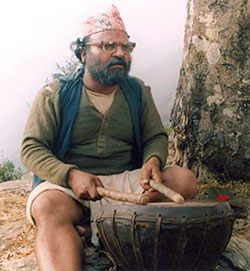 |
Set in the 1950s, the series is truly heart-warming. At a time when inter-caste marriage was almost unthinkable, Harihar, a Brahmin man, falls in love and weds Tulki, a Damini (a Dalit woman). When the villagers discover that he has married an untouchable, they shave his head and banish him from the village. Tulki gives birth to a baby boy. They are helped by Dhammare Damai, who takes pity on them. With no money and a new-born child, they agree to work as bonded labourers to Sher Bahadur, the landlord. Dalan is the story of how this couple and their children struggle for their freedom in society. Scriptwriter Aahuti says: "Dalan is the true depiction of how society viewed dalits from 1951."
Aahuti's story has been brought to life by director Nabin Subba. Dalan has established itself in the league of the Umesh Nath Aryal-directed Bhid Dekhi Bhidsamma, and Abiral Bagdacha Indrawati by director Badri Adhikari, and has given imitators of Hindi soaps something to copy. But there are a few weaknesses in the subject matter and in establishing the characters. The relationship between Harihar and Tulki is unclear, and questions have been raised as to what ignited such a union in 1951.
Since most of the actors involved are from the stage, the acting and dialogue appear theatrical. The cast includes Bhusan Pokhrel as Harihar, Babita Sharma as Tulki, Anup Baral as Juthe and Dia Maskey as Kali. According to Subba, the 44-part series has 300 actors.
It appears rather unconvincing in terms of its costumes, playback singing and editing. New daura suruwals have been smeared with dirt in places to give a feeling of poverty. White clothes have been patched with red, and vice versa. The subject matter of the story and the songs don't go well together, and the make-up of the actors is often overdone. Tulki of the 1950s looks no different from actresses of today, and the scenes where Tulki tries to commit suicide and Harihar goes to muglan are excessively long.
However, the series, funded by the European Union and produced for Rs 6 million, has attracted a large audience. Because it was filmed while the nation was still at war, the production unit had many problems. Says Subba: "The army's air patrols and Maoist cadres caused a lot of unnecessary trouble while we were shooting in the hills."


